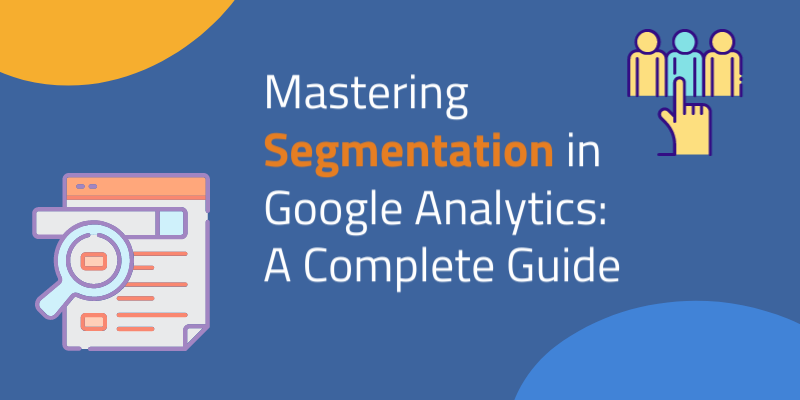As a marketer, you probably already know the importance of tracking and analyzing data to optimize your campaigns.
And when it comes to data analysis, Google Analytics is one of the most popular and powerful tools out there, with a staggering 75 million users.
But did you know that you can take your analysis a step further with segmentation? By isolating specific subsets of your data, you can gain deeper insights into your audience and improve your targeting strategies.
In this comprehensive guide, we’ll walk you through everything you need to know to master segmentation in Google Analytics.
So before we get into the details, let’s get the mini takeaway first so you can more easily understand the power of mastering segmentation in Google Analytics.
Analyzing data segment by segment can highlight patterns and trends that may go unnoticed in overall site data and can increase engagement and conversions. Best practices include starting with clear objectives, keeping it simple, using multiple segments in combination, testing, and refining.
So with the short answer in mind, let’s get in a bit deeper and find out exactly what segmentation means.
What is segmentation and why is it important?
Segmentation is essentially the process of dividing your website’s visitors into different groups based on specific characteristics or behaviors.
This allows you to analyze data for each group separately, which can give you valuable insights into how different segments use your website.
The possibilities for segmentation in Google Analytics are practically endless, from basic demographics like age and gender to behavioral traits like time spent on site, buying habits, and traffic source.
By segmenting your audience, you can better understand who is using your site, what they are looking for, and how they interact with your content.
This allows you to analyze each group separately and gain a clearer understanding of how they interact with your website or app.
For example, if you notice that visitors from certain locations have a higher conversion rate, you might want to target them with more personalized messaging or promotions.
So how do you set up segmentation in Google Analytics?
How to create a segment in Google Analytics
There are two main ways to create segments: standard and custom.
Standard segments are pre-built and can be found in the “Audience” and “Behavior” sections of Google Analytics.
These segments are based on common criteria, such as geography, device type, and new/returning visitors.
Custom segments, on the other hand, are created from scratch.
They allow you to specify exactly which criteria to use when dividing your visitors into groups.
Follow our 4 easy steps below to get started.
- Sign in to your Google Analytics account: Go to the analytics.google.com page and sign in with your account details. Once you’re in, you should see a list of your available website views. Click on one of the views you want to create a segment for.
- Go to the segment builder: Once you’re in your selected view, you’ll see a menu on the left side of the page. Click on the “Add Segment” button at the top of the menu. This will take you to the segment builder where you can start creating your custom segment.
- Define your segment criteria: The segment builder is where you define the criteria for your segment. You can choose from a range of options including demographic information, location, device, and behavior. For example, you could create a segment of users who have visited your website more than once, or users who have made a purchase on your site.
- Name and save your segment: Once you’ve defined your segment criteria, give it a name and click on the “Save” button. You can also choose to share your segment with other users in your account by clicking on “Sharing” and selecting the users you want to share it with.
Optimize Keyword and Landing Pages
Advanced segments allow you to drill down and segment traffic data along with acquired users to create better-targeted marketing campaigns.
By looking at users who enter your site through a specific location or keyword, you can identify the content they find the most relevant and explore ways to optimize it further.
You may identify pages that generate a high bounce rate and decide to improve their copy and design.
Alternatively, you can identify pages that drive a lot of traffic and use that information to create complementary content.
The beauty of advanced segments is that they enable you to focus your efforts on the most profitable areas of your website.
Advanced segments allow you to drill down and segment traffic data along with acquired users to create better-targeted marketing campaigns.
Using segments to analyze your data
Once you’ve set up your segments, the real magic begins.
By analyzing data for each segment independently, you can identify patterns and trends that may not be immediately apparent when looking at overall site data.
For example, you may find that mobile users have a higher bounce rate than desktop users, or that visitors from a certain geographic region spend more time on your site than others.
Armed with this information, you can then make targeted improvements to your site to address specific segments’ unique needs.
The possibilities are endless, but here are just a few examples:
- Compare the behavior of new visitors vs. returning visitors
- Analyze the performance of different traffic sources
- Check the effectiveness of your marketing campaigns on specific devices
- Find out which pages are most popular among certain age groups or genders
By analyzing your data segment by segment, you can uncover insights that might otherwise go unnoticed.
And with Google Analytics, it’s easy to visualize your data in charts and graphs that make it easy to spot trends and patterns.
One of the most powerful applications of segmentation in Google Analytics is in creating personalized experiences for your visitors.
By understanding each segment’s preferences and behaviors, you can tailor your site content and messaging to better resonate with specific groups.
For example, if you know that a large percentage of your visitors are interested in a specific product or service, you can create targeted landing pages and messaging that speak specifically to those users’ needs.
This can lead to a significant increase in conversions and overall engagement.
Tips for effective segmentation
While creating a segment is fairly straightforward, there are a few best practices to keep in mind to ensure you’re getting the most out of your data:
- Start with a clear objective: Before you create a segment, have a specific goal in mind. What question are you trying to answer? What insight do you hope to gain?
- Keep it simple: While it can be tempting to create dozens of segments, it’s usually more effective to focus on a handful of key segments that will have the biggest impact on your campaigns.
- Use multiple segments in combination: Instead of analyzing your data one segment at a time, try combining multiple segments to get a more complete picture. For example, you might want to look at the behavior of visitors from a specific location who also accessed your site from a mobile device.
- Test and refine: Segmentation, like any data analysis technique, is an ongoing process. Test different segments, refine your criteria, and constantly look for new insights to improve your campaigns.
Mastering Segmentation in Google Analytics – To end on…
By mastering segmentation in Google Analytics, you can gain a deeper understanding of your audience, improve your targeting strategies, and ultimately drive better results.
So whether you’re a seasoned data analyst or just starting out, experimenting with different segments and using the tips outlined in this guide will help you unlock the full power of this powerful analytics tool.





